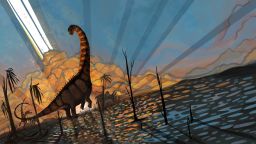In a groundbreaking discovery, researchers have revealed that the remains of a 66 million-year-old dinosaur known as a “mummy” are actually the result of a perfect clay mask. This revelation stems from extensive studies conducted in the Lance Formation of eastern Wyoming, an area recognized for its wealth of remarkably preserved dinosaur fossils.
The research team, led by paleontologist Dr. Paul Sereno from the University of Chicago, focused on two specimens of the duck-billed dinosaur, Edmontosaurus annectens, unearthed in 2000 and 2001. These fossils, along with others discovered in the region, have contributed to what the researchers have dubbed “the mummy zone.” Notably, the area spans less than 10 kilometers (6 miles) and has yielded several specimens showcasing well-preserved attributes such as skin, hooves, and spikes.
The initial findings date back to the early 1900s when fossil hunter Charles Sternberg discovered two near-complete skeletons of Edmontosaurus. The exceptional preservation of these fossils allowed Sternberg and paleontologist H.F. Osborn of New York’s American Museum of Natural History to identify what they believed were skin impressions. In a recent study, Sereno revisited this concept, emphasizing the need to redefine these impressions as “renderings” due to their unique preservation process.
Unraveling the Mystery of Dinosaur Preservation
The research utilized advanced techniques, including CT scanning, 3D imaging, and X-ray spectroscopy, to analyze the two Edmontosaurus specimens. Despite extensive sampling, the team did not detect remnants of soft tissue. Instead, they identified a thin layer of clay, measuring less than one-hundredth of an inch, that had formed over the skin of the dinosaurs.
“It’s so real-looking, it’s unbelievable,” Sereno noted, highlighting the striking fidelity of the clay mask. This phenomenon can be attributed to environmental conditions during the Late Cretaceous Period, which saw cycles of drought and monsoon rains. The study suggests that a drought likely caused the death of these dinosaurs, leading to sun-drying of their carcasses. Subsequently, a flash flood buried the remains in sediment, allowing a film of bacteria to form a clay layer that preserved the unique morphology of the skin.
Dr. Anthony Martin, a professor at Emory University, explained the significance of the clay’s interaction with biological surfaces, stating, “Clay minerals have a way of attracting to and sticking onto biological surfaces, ensuring a molding that can faithfully reproduce the outermost surfaces of a body, such as skin and other soft tissues.”
Insights into Dinosaur Anatomy and Evolution
The research further sheds light on the physical characteristics of Edmontosaurus. The dinosaur, which could reach lengths of over 12 meters (40 feet), featured a fleshy crest along its neck and spine, along with a row of spikes along its tail. Notably, the findings revealed that the creature possessed hooves, marking it as the oldest land animal confirmed to have this feature and the first known example of a hooved reptile.
“Sorry, mammals, you didn’t invent it,” Sereno humorously remarked, referencing the significance of this discovery. Although footprints had previously suggested the presence of hooves in Edmontosaurus, this study provides definitive evidence.
The research, published in the journal Science on July 13, 2023, marks a significant advancement in paleontological studies, enhancing the understanding of how fossils can form and what they reveal about ancient life. As the study highlights, deciphering the conditions leading to fossilization can help scientists target future excavations, potentially uncovering more dinosaur mummies in the process.
By unraveling the details of these ancient creatures, researchers continue to bring the history of life on Earth into sharper focus, painting a more vivid picture of the dinosaurs that once roamed our planet.



